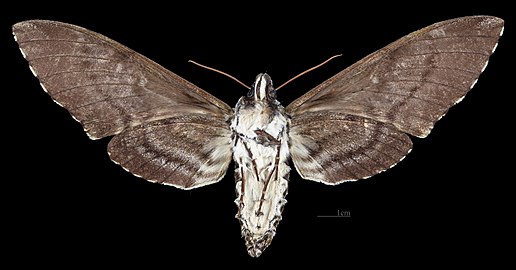
The Sphingidae are a family of moths commonly called sphinx moths, also colloquially known as hawk moths, with many of their caterpillars known as "hornworms"; it includes about 1,450 species. It is best represented in the tropics, but species are found in every region. They are moderate to large in size and are distinguished among moths for their agile and sustained flying ability, similar enough to that of hummingbirds as to be reliably mistaken for them. Their narrow wings and streamlined abdomens are adaptations for rapid flight. The family was named by French zoologist Pierre André Latreille in 1802.
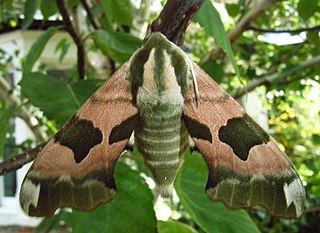
Mimas tiliae, the lime hawk-moth, is a moth of the family Sphingidae. It is found throughout the Palearctic region and the Near East, and has also been identified in Canada's east and western provinces and in northern Spain (Europe). The species was first described by Carl Linnaeus in his 1758 10th edition of Systema Naturae.

Laothoe populi, the poplar hawk-moth, is a moth of the family Sphingidae. The species was first described by Carl Linnaeus in his 1758 10th edition of Systema Naturae. It is found throughout the Palearctic region and the Near East and is one of the most common members of the family in the region. It is distinctive due to its habit of resting with its hindwings held further forward than the forewings.

Manduca rustica, the rustic sphinx, is a moth of the family Sphingidae. The species was first described by Johan Christian Fabricius in 1775.

Cocytius antaeus, the giant sphinx, is a moth of the family Sphingidae. The species was first described by Dru Drury in 1773.
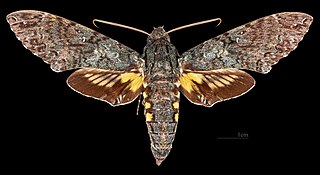
Amphonyx duponchel, or Duponchel's sphinx, is a moth of the family Sphingidae. The species was first described by Felipe Poey in 1832.

Eumorpha labruscae, the gaudy sphinx, is a moth in the family Sphingidae.

Paonias excaecata, the blinded sphinx, is a moth of the family Sphingidae. The species was first described by James Edward Smith in 1797.
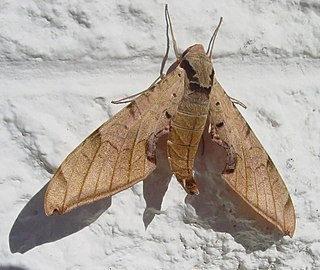
Protambulyx strigilis, the streaked sphinx, is a moth of the family Sphingidae prevalent in the Americas from Florida to Central and South America. The species was first described by Carl Linnaeus in 1771.
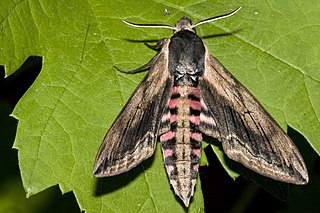
Sphinx ligustri, the privet hawk moth, is a moth found in most of the Palearctic realm. The species was first described by Carl Linnaeus in his 1758 10th edition of Systema Naturae.

Erinnyis lassauxii, or Lassaux's sphinx, is a moth of the family Sphingidae.

Eumorpha satellitia, the satellite sphinx, is a moth of the family Sphingidae. The family was first described by Carl Linnaeus in 1771. It lives from Brazil and northern Argentina north through Central America, Mexico, and the West Indies to south Texas and southern Arizona.
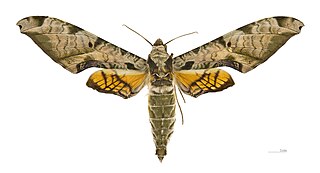
Protambulyx eurycles is a species of moth of the family Sphingidae first described by Gottlieb August Wilhelm Herrich-Schäffer in 1854.

Marumba quercus, the oak hawk-moth, is a moth of the family Sphingidae. The species was first described by Michael Denis and Ignaz Schiffermüller in 1775.

Deidamia inscriptum, the lettered sphinx, is a species of moth of the family Sphingidae. It is the only member of the genus Deidamia. The species was first described by Thaddeus William Harris in 1839 and the genus was erected by James Brackenridge Clemens in 1859.

Amphimoea is a monotypic moth genus in the family Sphingidae erected by Walter Rothschild and Karl Jordan in 1903. Its only species, Amphimoea walkeri, the Darwin hawkmoth, described by Jean Baptiste Boisduval in 1875, is found from Mexico south to Argentina.
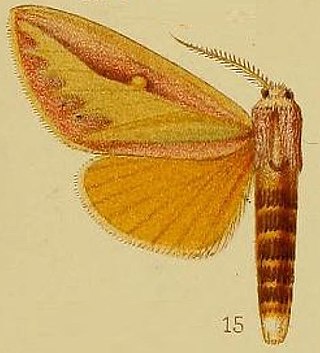
Leucophlebia afra is a moth of the family Sphingidae. It is found from Senegal to northern Uganda and Sudan in the east, and to Angola in the west.

Gnathothlibus eras is a moth of the family Sphingidae.

Manduca scutata is a moth of the family Sphingidae.

Meganoton analis, the grey double-bristled hawkmoth, is a moth of the family Sphingidae. It is known from India, Nepal, southern and eastern China, northern Thailand, northern Vietnam, Peninsular Malaysia, Indonesia, Taiwan, the southern part of the Russian Far East, South Korea and Japan.



